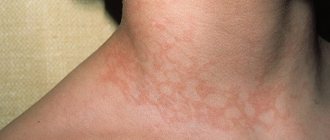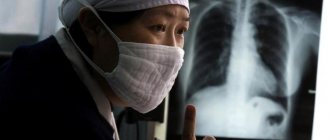Pulmonary tuberculosis
Which doctors should I contact?
Tuberculosis is treated by phthisiatricians, but with the first complaints they most often turn to a general practitioner, pediatrician or pulmonologist, who, after an examination and diagnostic measures, will recommend a consultation with a phthisiatrician.
Treatment of pulmonary tuberculosis
The success of treatment largely depends on early diagnosis of the disease. Tuberculosis therapy is long-term and ranges from 4 months to several years.
Stopping medication on your own, skipping or reducing the dosage can cause resistance, that is, resistance of mycobacteria to antibiotics. During treatment, you must stop smoking and drinking alcohol.
Tuberculosis therapy involves a combination of several antibacterial drugs. Basically, all medications are taken in tablet form, but at the onset of the disease or in severe cases they require intravenous administration.
Tuberculosis treatment is carried out both at home and in a specialized hospital. Hospitalization is indicated for the initial detection of tuberculosis, for the treatment of severe forms of tuberculosis and for surgical treatment of pulmonary tuberculosis.
During treatment for tuberculosis, it is very important to eat well, getting the required amount of calories, vitamins and nutrients from food.
The calorie content of food should be 10% higher than with a normal lifestyle. Dairy products, lean meat, fish, and nuts are rich in protein, which is necessary to strengthen the immune system. Be sure to include vegetables, herbs, and whole grains in your menu. You should avoid fast food, fatty, smoked foods, sugar and sweet carbonated drinks.
Complications
Nonspecific complications characteristic of many pulmonary diseases include hemoptysis, pulmonary hemorrhage, and spontaneous pneumothorax. Spontaneous pneumothorax is the entry of air into the pleural cavity due to damage to lung tissue. The presence of air in the pleural cavity compresses the lungs and interferes with the normal breathing process. Cases have been described where the formation of bronchopleural fistulas leads to pneumothorax.
Rare but dangerous complications include: atelectasis (collapse of part of the lung, which ceases to participate in gas exchange and the breathing process), lung abscess (formation of an abscess in the lung tissue), amyloidosis of internal organs (as a result of a long-term inflammatory process, protein metabolism is disrupted in organs amyloid protein begins to be deposited, as a result of which their normal functioning is disrupted), chronic pulmonary failure.
Specific complications characteristic of pulmonary tuberculosis include: tuberculosis of the bronchi, trachea, larynx, root of the tongue; tuberculous pleurisy; tuberculous empyema is an accumulation of pus in the pleural cavity.
Prevention of pulmonary tuberculosis
Specific prevention includes vaccination.
Vaccination is carried out for newborn children in the maternity hospital on the 3rd–7th day in the absence of contraindications.
The vaccine is administered intradermally, after which a local tuberculosis process is formed, which is not dangerous to general health. Subsequently, the body develops specific immunity against mycobacteria. This means that a vaccinated child with good post-vaccination immunity, when encountering mycobacteria, either does not become infected or suffers a mild infection.
Immunity acquired after BCG vaccination lasts an average of 5 years. Repeated vaccinations are carried out at 7 and 14 years of age.
Prevention of tuberculosis in adults includes annual medical examination with fluorography of the lungs.
Sources:
- Karachunsky M.A. Differential diagnosis of pulmonary tuberculosis // Pulmonology and allergology. – T.1. – 2005. P. 6–9.
- Federal clinical guidelines for the diagnosis and treatment of respiratory tuberculosis. Russian Society of Phthisiatricians. – 2014. – P. 43.
IMPORTANT!
The information in this section cannot be used for self-diagnosis and self-treatment. In case of pain or other exacerbation of the disease, diagnostic tests should be prescribed only by the attending physician. To make a diagnosis and properly prescribe treatment, you should contact your doctor.
T-SPOT.TB
T-SPOT.TB is a modern method of immunological diagnosis of latent tuberculosis infection using a blood test.
T-SPOT TEST FOR TUBERCULOSIS METHOD IS RECOMMENDED:
- If the patient refuses to undergo skin tests and fluorography;
- If extrapulmonary forms of TV are suspected;
- If the patient is found to have an allergy to tuberculin (according to the medical history), allergic diseases, skin diseases, epilepsy, acute and exacerbation of chronic diseases;
- Patients for whom subcutaneous tests are contraindicated or difficult due to exacerbation of the underlying disease.
- When a false positive Mantoux reaction is detected in children vaccinated with the BCG vaccine.
- In people who have visited countries with high incidence of tuberculosis (Africa, Asia)
- In pregnant women in case of contact with a patient with tuberculosis or presence of symptoms;
- Patients with HIV infection, especially those with a reduced level of CD4 protein cells;
- For tumor diseases, if a person is undergoing radiation or chemotherapy treatment
- For autoimmune and other pathologies leading to immune suppression;
Standards and detected deviations
Normally, there should be no mycobacteria in the body. Their presence is regarded as a positive result of the diagnosis of tuberculosis. A negative result indicates that the patient does not have this pathology. Some methods are nonspecific and do not have high diagnostic value. They are used to assess general condition. Bacteriological techniques are more specific and their positive results can be considered confirmation of the diagnosis. A negative result is a reason for repeat tests if there are clinical signs of the disease.
State health care institution
"Lipetsk Regional Tuberculosis Dispensary"
The regional anti-tuberculosis dispensary is the same age as the Lipetsk region, organized by order No. 135 of the Lipetsk Department of Health dated July 28, 1954, deployed with 50 beds in the buildings of the former noble estate on Lenin Street.
The chief doctors of the regional TB dispensary at different times were M.B. Shcheprova, Iraida Konstantinovna Mikheeva, Moses Yakovlevich Perchik, Abdulla Muslimovich Guseinov, Nina Viktorovna Murova, Natalya Ivanovna Anokhina, Sergey Nikolaevich Popov, Oleg Viktorovich Zhilin, Olga Aleksandrovna Ovchinnikova, Korostelev Alexey Viktorovich.
In 1962, a bacteriological service was created on the basis of the dispensary, headed by bacteriologist Lev Konstantinovich Moskalev, who participated in the development of new methods for bacteriological diagnosis of tuberculosis, on which 4 All-Russian and 1 All-Union conferences were held.
The bacteriological diagnostic methods developed in the laboratory were approved by the USSR Ministry of Health for practical use.
In 1965, a pulmonary surgical department was organized under the leadership of surgeon Lev Abramovich Giterman. The department performed lung surgeries of varying complexity, including those for cancer and other diseases.
Diagnostic and therapeutic bronchoscopy, gastric fiberoscopy, and colonoscopy were performed in the endoscopic department of the dispensary.
The incidence of tuberculosis in the 60s was very high and amounted to 140 per 100 thousand population. Mortality rate is 27 per 100 thousand population.
Actively carried out organizational and methodological work with medical institutions in the region to organize early detection and prevention of tuberculosis among the population contributed to improving the diagnosis of tuberculosis and preventing the spread of tuberculosis infection.
In the early 70s, the onslaught of tuberculosis infection was contained and the incidence and mortality from tuberculosis decreased by 2 times.
Since 1972, the dispensary, with a bed capacity of 310 beds and an outpatient department for 500 visits per shift, has been located on the street. Kosmonavtov 35/1, Lipetsk.
Doctors made a great contribution to the fight against tuberculosis and the training of young specialists: Yamchinova Anna Georgievna, Romashova Nina Georgievna, Burenok Albina Vladislavovna, Burenok Anatoly Alexandrovich, Masik Svetlana Stepanovna, Suslova Alexandra Ivanovna, Ivanova Liliya Mikhailovna, Zelenin Vasily Petrovich, Falin Boris Alexandrovich, Sokolov Vladimir Alexandrovich, Zelenina Albina Evgenievna, Fursova Elena Dmitrievna. Kastornaya Valentina Aleksandrovna, Kovaleva Anna Dmitrievna, Dmitrieva Maria Petrovna, Mikhailova Zoya Aleksandrovna.
Since 2000, the tuberculosis pulmonary surgery department has widely used minimally invasive video-thoracoscopic operations and high-tech methods of surgical treatment of lung diseases, modernized plastic surgeries on the lungs.
In 2009, the method of bronchoblocking was successfully introduced into the practice of the endoscopy department.
In the tuberculosis department for patients with urogenital tuberculosis, conservative and prompt specialized medical care is provided to patients with extrapulmonary forms of tuberculosis.
Innovative methods for diagnosing tuberculosis have been introduced into examination practice - the Diaskintest test, a hardware method for accelerated PCR diagnostics and determination of drug resistance of the pathogen to anti-tuberculosis drugs "Gene Xpert", which has reduced the duration of diagnosis of tuberculosis, especially in children and adolescents.
In 2012, the phthisiatric service of the region was reorganized, the Lipetsk city TB dispensary became part of the regional dispensary, in 2014 the tuberculosis department of the Gryazinsk interdistrict hospital was added, and in 2015 the Eletsk city TB dispensary was added as a branch.
In 2021, a laboratory building with a clinical diagnostic laboratory and a Bacteriological Diagnostics Center was put into operation at the State Healthcare Institution "LOPTD", and on the eve of 2021, a children's department building was commissioned, where outpatient and inpatient anti-tuberculosis care is provided to children and adolescents with the opportunity to continue their education remotely.
After the merger and reorganization of the State Healthcare Institution “LOPTD”, the hospital’s capacity is 392 round-the-clock beds, located in 3 buildings in 8 inpatient departments and 39 day hospital beds.
At the end of 2021, in terms of the epidemiological situation regarding tuberculosis, the Lipetsk region took 14th ranking among the constituent entities of the Russian Federation.
Currently, the glorious traditions of domestic medicine in the fight against tuberculosis at the State Healthcare Institution “LOPTD” are continued by the chief physician Andrey Viktorovich Staroselsky.
As of January 1, 2021, the regional dispensary employs 571 employees, including 60 doctors and 224 paramedical personnel. This is a highly qualified team, 58% of doctors and 75% of nurses have qualification categories and were awarded the title “Excellence”
Healthcare" 15 employees, 1 Honored Doctor, 2 Honored Health Worker of the Lipetsk Region. 38 people were awarded a Certificate of Honor from the Ministry of Health of the Russian Federation, and 11 people received a Letter of Gratitude from the Minister of Health.
The regional health department and the regional dispensary receive numerous thanks from patients for the dispensary staff.
State Healthcare Institution “LOPTD” is a member of the National Register “Leading Healthcare Institutions of Russia”.
The state health care institution “Lipetsk Regional Tuberculosis Dispensary” continues to live and fight tuberculosis.
What is tuberculosis, the causative agent of the disease
- Tuberculosis is a chronic infectious bacterial disease caused by the pathogen Mycobacterium tuberculosis complex (popularly known as Koch's bacillus).
- This microorganism was first isolated by the German scientist Robert Koch in 1882, but the disease itself has been known for a very long time. Researchers have even found traces of Mycobacterium tuberculosis in the remains of ancient Egyptian mummies.
- These microorganisms are highly resilient in the environment. In a humid and dark place at a temperature of 23 ° C they can be stored for up to 7 years, in a dark and dry place - up to 10-12 months, in a dry and light place - about 2 months.
- The stick lives in water for up to 5 months, in soil for up to 6 months, in raw milk for up to 2 weeks, in cheese and butter for about a year, on the pages of books for about 3 months. However, these bacteria die when exposed to substances containing chlorine, tertiary amines, hydrogen peroxide, and also when exposed to ultraviolet irradiation. They can take low-hazard L-forms, which are present in the human body, but do not cause an acute process.
Symptoms, clinical manifestations
In the early stages, tuberculosis is practically asymptomatic. As it develops, the patient's condition worsens, but no specific symptoms are observed. Clinical signs are increased fatigue, weakness, sudden weight loss for no apparent reason, temperature 37-38 °C that does not subside for a long time, night sweats. The face becomes pale and a blush appears on the cheeks. Tuberculosis progresses much faster in children than in adults due to an undeveloped immune system.
The pulmonary form of tuberculosis is accompanied by a cough. At first it is not strong, but over time its intensity increases. If it continues for more than three weeks, you should consult a doctor immediately. The cough is initially dry, paroxysmal, especially at night and in the morning. Later, yellow-green sputum begins to be released, and at the cavity stage, hemoptysis is observed.
With tuberculosis of the meninges and brain, sleep disorders and headaches are added to the symptoms of general intoxication, the intensity of which gradually increases. Then, stiff neck, Kernig and Brudzinski symptoms, and neurological disorders appear.
The symptoms of tuberculosis of the digestive organs are similar to other diseases of this department: dyspepsia, abdominal pain, and later blood in the stool. Damage to bones and joints manifests itself in the same way as arthritis, kidneys - it has symptoms of nephritis: back pain, blood in the urine. With skin tuberculosis, dense nodules under the epidermis are observed, which enlarge and burst with the release of a cheesy mass.
Are you experiencing symptoms of tuberculosis?
Only a doctor can accurately diagnose the disease. Don't delay your consultation - call
T-SPOT.TB: who needs it and when
All existing tests can be divided into two groups – screening and confirmatory. The main advantage of the former is their low cost; screening examinations should cover as many people as possible. In adults, screening for tuberculosis is fluorography. However, it can only detect lesions in the lungs, but not carriage of infection or latent tuberculosis. For children for whom x-rays are not indicated, skin tests are performed. The problem is that they often give false positive results. And in order to subsequently save parents and the child from visiting doctors and the need in some cases to still do an X-ray examination, you can perform a blood test - for example, T-SPOT.TB.
Such an analysis can be recommended not only if the skin test result is positive. The second case is when, in principle, it is impossible to make a Mantoux test. It's not just a matter of parents' refusal; there are medical contraindications. The third situation when a blood test is indicated is an examination of people at risk: first of all, medical personnel, people with immunodeficiency conditions (HIV, systemic diseases requiring the use of immunosuppressants, cancer, etc.), those who have been in contact with a patient with tuberculosis . In principle, if a person who does not fall into any of the categories has had, for example, fluorography, but for some reason he is not satisfied with the negative result (let’s say he has warning symptoms), he can also clarify the situation with the help of such a test.
How is tuberculosis transmitted?
The main source of infection are people with open disease. Routes of transmission of the pathogen:
- airborne - when sneezing and coughing, bacteria end up in the air, which is inhaled by healthy people. In addition, microorganisms settle in dust and remain there for a long time;
- nutritional – through eating contaminated foods – milk, eggs, etc. However, in this case, a larger number of bacteria is required compared to the airborne route;
- contact - in direct contact of damaged skin with healthy skin or through the conjunctiva of the eye, but this is rarely observed;
- during intrauterine development from the mother - the fetus becomes infected through the placenta, but this also occurs infrequently.










